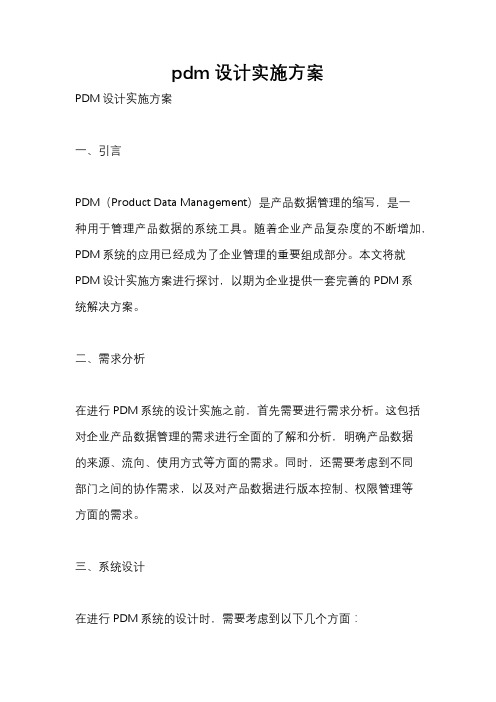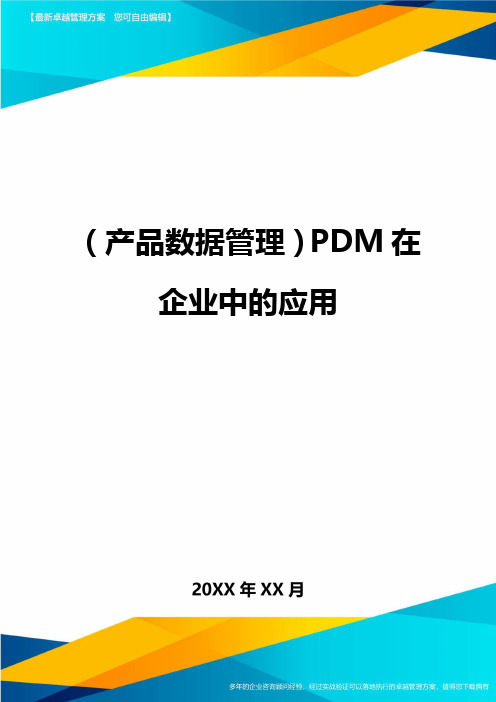PDM项目IT05. Enterprise Data Model 0205【精品文档】
pdm方案

pdm方案PDM方案1. 引言PDM(Physical Data Model)是物理数据模型的缩写,是软件开发过程中设计和管理数据库的重要环节之一。
PDM方案是指针对特定项目或系统的数据库设计方案。
本文将介绍PDM方案的重要性,以及如何编写一个全面有效的PDM方案。
2. PDM方案的重要性PDM方案是数据库设计的基础,它对数据库的结构、表关系、数据类型等进行详细规划,明确了数据库的架构和逻辑。
一个合理的PDM方案可以提高数据库的性能、可靠性和可维护性,同时减少日后修改和调整的工作量。
PDM方案的编写不仅仅是为了满足当前项目的需求,更是为了未来的扩展和维护考虑。
一个好的PDM方案应该具备清晰的表结构关系、恰当的索引设计、适当的数据冗余以及合理的安全机制。
3. 编写PDM方案的步骤编写一个全面有效的PDM方案需要按照一定的步骤进行,以下是编写PDM方案的常用步骤:3.1 确定需求在编写PDM方案之前,首先需要明确项目的需求和目标。
通过与项目团队和需求方沟通,了解系统的功能和业务流程,确定数据库的核心数据实体和关系。
这将为后续的数据建模提供基础。
3.2 数据建模数据建模是PDM方案的核心环节。
在数据建模过程中,可以使用ER图或UML图等工具来表示实体、关系和属性。
通过数据建模,可以清晰地表示数据库的结构和逻辑,方便后续的物理设计和数据管理。
3.3 表设计根据数据建模的结果,进行具体的表设计工作。
包括确定各个表的字段、数据类型、约束条件等。
表设计时需要考虑数据的规模、业务逻辑和性能需求,合理地划分字段和表结构。
3.4 索引设计良好的索引设计有助于提高数据库的查询性能。
在表设计完成后,根据查询需求和约束条件,确定需要建立的索引,并设置合适的索引类型和属性。
同时,需要注意索引的数量和大小,避免过多或过大的索引对性能造成负面影响。
3.5 安全设计数据库的安全性是PDM方案中不可忽视的一部分。
在设计PDM方案时,需要考虑用户权限管理、数据加密、日志记录等安全措施。
pdm设计实施方案

pdm设计实施方案PDM设计实施方案一、引言PDM(Product Data Management)是产品数据管理的缩写,是一种用于管理产品数据的系统工具。
随着企业产品复杂度的不断增加,PDM系统的应用已经成为了企业管理的重要组成部分。
本文将就PDM设计实施方案进行探讨,以期为企业提供一套完善的PDM系统解决方案。
二、需求分析在进行PDM系统的设计实施之前,首先需要进行需求分析。
这包括对企业产品数据管理的需求进行全面的了解和分析,明确产品数据的来源、流向、使用方式等方面的需求。
同时,还需要考虑到不同部门之间的协作需求,以及对产品数据进行版本控制、权限管理等方面的需求。
三、系统设计在进行PDM系统的设计时,需要考虑到以下几个方面:1. 数据模型设计:需要根据企业的实际情况设计合理的数据模型,包括产品结构、BOM(Bill of Materials)管理、文件管理等方面的设计。
2. 工作流程设计:需要根据企业的业务流程设计合理的工作流程,确保产品数据在不同部门之间的流转和协作顺畅高效。
3. 权限管理设计:需要设计合理的权限管理机制,确保不同用户在系统中的操作权限受到严格控制,以防止数据泄露和误操作。
4. 接口设计:需要考虑PDM系统与其他系统的接口设计,确保PDM系统能够与企业现有的系统进行无缝集成。
四、系统实施在进行PDM系统的实施时,需要考虑到以下几个方面:1. 项目规划:需要对PDM系统的实施进行全面的规划,包括项目周期、预算、人力资源等方面的规划。
2. 系统部署:需要进行系统硬件和软件的部署,确保系统能够稳定运行。
3. 数据迁移:需要对现有的产品数据进行迁移,确保数据在新系统中的完整性和准确性。
4. 培训和支持:需要对企业员工进行系统培训,确保员工能够熟练操作新系统,并提供系统运行的技术支持。
五、系统运营在PDM系统实施完成后,需要进行系统的运营和维护工作。
这包括对系统进行定期的维护和更新,确保系统能够持续稳定地运行。
产品数据管理PDM在企业中的应用

(产品数据管理)PDM在企业中的应用PDM在企業中的應用第一章PDM入门知识1.PDM定义2.为什么要实行PDM3.CAD/CAM用户需知道的PDM基本知识4.非凡的优势PDM的好处—投资可在整个企业中得到回报5.如何决定你是否需要PDM系统在管理钢丝上行走第二章PDM实施方法1.实施PDM:成功之关键2.企业如何实施PDM第三章PDM的应用1.产品数据管理技术及其最新进展2.产品数据管理系统功能分析------附:艾克斯特编码系统在潍柴的应用3.产品数据管理系统功能与应用分析4.PDM在企业范围内的作用5PDM与企业信息集成6.PDM的管理功能第四章PDM在制造企業中的應用案例分析1.东风汽车公司锻造厂的PDM解決方案2.武汉天喻面向汽车制造业产品数据管理解决方案3.顺特电气(组变产品部)PDM实施纪实PDM在企業中的應用第一章PDM入门知识走进PDMPDM定义为什么实行PDMCAD/CAM用户需知道的PDM基本知识非凡的优势PDM的好处—投资可在整个企业中得到回报如何决定你是否需要PDM系统在管理钢丝上行走走进PDM肖文引言什么是PDM?这是一个既易回答久颇具争议的问题。
说它容易回答,是因为自从它面市这十多年来,很多公司对它进行过研究,下过定义,一些“标准”的说法似乎可以信手拈来;说它颇具争议,是因为真正意义上的PDM,远非三言两语的“定义”可以“简而言之”。
实际上,从来没有纯粹、抽象的“PDM”,也没有哪一家企业单纯地“上了一个PDM系统”,它一定与企业的具体目标相辅相成,也不可把不同层次的PDM混为一谈,因为不同层次的PDM应用于企业不同层次的需求,企业的终极目标是企业级信息集成。
笔者将在这个系列的文章中,试图对这些问题予以说明和澄清。
不妥之处,欢迎指正。
首先,本文将探讨产生PDM的历史、社会和有关技术原因。
[摘要]本文简述了PDM(产品数据管理)产生之基础、通用定义、适用范围以及一些相关基本问题,让读者走近PDM,认识其一般外在特征。
描述pdm实施的目标内容与步骤

描述PDM实施的目标内容与步骤目标内容实施产品数据管理(Product Data Management,简称PDM)的主要目标是通过优化产品数据的管理和使用,提高生产效率、加快产品上市时间,并保证产品数据的可靠性和一致性。
以下是PDM实施的主要目标内容:1.集中化数据管理:将分散在不同系统和部门的产品数据集中管理,提高数据的可访问性和共享性。
2.数据版本控制:实现对产品数据的版本控制,确保每个版本的数据都能被跟踪和审查。
3.协同工作:促进多个部门和团队之间的协作和信息共享,提高工作效率。
4.改进工作流程:通过自动化和标准化工作流程,提高产品开发和生产过程的效率。
5.减少错误和重复工作:通过减少人为错误和重复工作,降低成本和提高质量。
实施步骤下面是PDM实施的一般步骤,可以根据具体情况进行调整和扩展:1.需求分析–对现有的产品数据管理流程进行分析和评估。
–与相关部门和团队沟通,了解他们的需求和期望。
–定义PDM实施的目标和范围。
–制定项目计划和时间表。
2.系统选择–调研市场上的PDM系统,了解各个系统的功能和适用性。
–与供应商进行洽谈并进行系统演示。
–根据需求和预算选择合适的PDM系统。
3.系统设计–根据需求和系统选择,设计PDM系统的架构和数据模型。
–确定数据的存储和访问方式。
–制定数据标准和命名规则。
4.系统实施–进行系统部署和安装。
–进行系统配置和定制,根据实际需求进行调整。
–导入现有的产品数据到PDM系统中。
5.用户培训–为使用PDM系统的员工提供培训,教授基本操作和功能。
–建立培训计划,包括培训材料和培训课程。
6.系统测试–进行系统测试,包括功能测试和性能测试。
–修复和调整系统中的问题和不足。
–确保系统能够满足预期的目标和需求。
7.系统上线–上线前进行系统的最后调整和优化。
–与相关部门和团队进行系统的验收。
–迁移现有的数据到正式的PDM系统中。
8.系统运维–建立日常系统运维和管理的流程。
PDM系统功能介绍

PDM系统功能介绍1 PDM的常见功能介绍到目前为止,还没有一个商用PDM软件拥有全部可罗列的PDM功能,其中有的功能构件还有待于进一步发展和完善。
但是,一般PDM系统都包括文档管理、产品配置管理及工作流程管理等最基本的功能,能对产品的整个生命周期进行完整的描述和控制,因此,PDM在企业中的作用已经普遍为大家所认同。
1.1 电子仓库1.1.1 电子仓库介绍在企业中,大量与产品相关的数据往往分布在多部门,甚至是多区域中,而且这些数据的格式也是多样的,如文本文件、数据库、图纸文件等,对这些数据的查询、浏览、共享,以及结合工作流程来管理这些数据等,都是企业在进行信息集成时经常遇到的问题。
PDM管理的主要对象是产品的“元数据”,即有关产品信息的信息,其实现基础是电子仓库(Electronic Data Vault)。
实施并行工程所需要的“在正确的时间、把正确的数据、按正确的方式、传递给正确的人”对PDM数据管理提出了更高的要求。
电子仓库(Data Vault)是PDM最基本的加工NC代码等。
(3)工艺数据是指CAPP系统在工艺设计过程中所使用和产生的数据,分为静态与动态两类。
静态工艺数据主要是指工艺设计手册上己经标准化和规范化的工艺数据,以及标准工艺规程等;动态工艺数据主要指在工艺规划过程中所产生的相关信息。
工艺知识是指支持CAPP系统工艺决策所需的规则。
工艺知识主要分为选择性规则和决策性规则两大类。
(4)生产管理数据生产计划与管理指的是对产品生产过程的计划与管理。
生产中的数据可分为两类:一类是基础数据,这类数据比较稳定;另一类是动态数据,这类数据有一定的时间性,且相对比较独立,不受其它数据存在与否的影响。
无论是哪类数据,都要求准确、完整,其准确度应在93%以上,物料清单的准确度应更高,为98~99%。
(5)维修服务数据如常用备件清单、维修记录和使用手册等说明文件。
(6)专用文档如电子行业的电气原理图或布线图、印刷电路板图和零件插件图等。
- 1、下载文档前请自行甄别文档内容的完整性,平台不提供额外的编辑、内容补充、找答案等附加服务。
- 2、"仅部分预览"的文档,不可在线预览部分如存在完整性等问题,可反馈申请退款(可完整预览的文档不适用该条件!)。
- 3、如文档侵犯您的权益,请联系客服反馈,我们会尽快为您处理(人工客服工作时间:9:00-18:30)。
Information Technology Strategy and Plan ConsultancyPhase 3 ReportFebruary, 1999IT05. Enterprise Data ModelScope and ObjectiveThe objective of this project is to define the Enterprise Data Model for Huawei based on the I/T Architecture defined in Phase 2 of the ITS&P consultancy project. The Enterprise Data Model will help Huawei to build up the process to standardise meanings (definition) of critical business information within the corporation. With the data standard and procedures of defining data elements set up, developers and users will know how these information is maintained so that data integrity can be ensured and conflicting information sources can be consolidated. F rom Huawei I/T’s perspective, the Enterprise Data Model contributes to the selection of application packages and development of new application programs. This Enterprise Data Model and the associated process, ownership, roles and responsibilities for its on-going maintenance should be communicated to Huawei management, I/T and selected users.The scope of this project includes:∙Define the Enterprise Data Model, which consists of a conceptual data model, the high level entities, some key attributes, their relationships and data standards, for the whole Huawei corporation based on the I/T Architecture developed in Phase 2 of ITS&Pconsultancy project, business requirements and existing application environment.∙Define the process, ownership, roles and responsibilities for on-going maintenance of the Enterprise Data Model.∙Communicate the Enterprise Data Model to Huawei management, I/T and selected user groups.Specifically excluded from the scope of this project are the following:∙Operational data will not be covered in the Enterprise Data Model.∙Some information is maintained for operational or tactical reason. An example is account balance for meals taken by an employee.∙Logical data model will not be part of the deliverables as the logical data model should be established based on the requirements of each business area. The logical model of each business area must be designed to align with the conceptual data model standard and guidelines defined in this project.∙Physical database design will not be covered in this project.∙As Huawei adopts an acquire-and-manage strategy, unless a new application is developed, the physical database design will be dictated by packages. TheEnterprise Data Model can thus guide package selection and reduce the problem of data integrity in the long run but it should not, at this stage, define the design ofphysical database.Note: This project has specifically excluded any reference to Year 2000 capability including Year 2000 contingency planning and compliance issues. As such the IBM consultant team has not provided any advice nor does it make any recommendations in respect of ensuring Year 2000 compliance for any existing or proposed systems. In all cases where technology solutions are referenced the technology supplier should be contacted to determine Year 2000 compliance status.Business BenefitsIssues being resolvedThis project will have a positive impact on overcoming the following specific issues:∙Information is captured, used and maintained within user groups but not shared across them.∙Lack of process to define data standard, maintain data standard.∙Lack of corporate-wide definition of data accessed and conformed by applications.∙Data integration issue as reflected in I/T survey conducted in Phase 1 of the ITS&P consultancy project.Intangible benefitsThis project will provide the following intangible benefits:∙Improve the quality, accuracy and integrity of information.∙Improve quality of business decisions.∙Reduce business process cycle times.∙Promote re-use and sharing of data.∙Reduce data redundancy.∙Reduce the development cycle time and maintenance effort.∙Position the future use of datawarehouse application.Tangible benefitsThis project will provide the following tangible benefits:∙Faster turnaround time in application development.∙Reduction in number of data integrity problems.ApproachMajor implementation activities to be undertaken1. Initiate project.2. Based on the projects identified in Phase 1 to come up with the data scope for the future5 years.3. Define the data standard in Huawei.4. Define the templates for entities, attributes, domains and integrity enforcementrequirements.5. Identify tools (like Word, Excel etc. ) to support the templates.6. Identify the possible data modelling case tools to be used in Huawei for modelconstruction and data dictionary documentation.7. Build up the conceptual data model, high level entities and high level attributes. Definethe corresponding relationships with business rules requirements.8. Define the process to check in/out data definition of entities and attributes within theenterprise data model. Define the roles and responsibilities to support the definedprocess.9. Document the conceptual data model, process, roles and responsibilities as thedeliverable of this project.。
